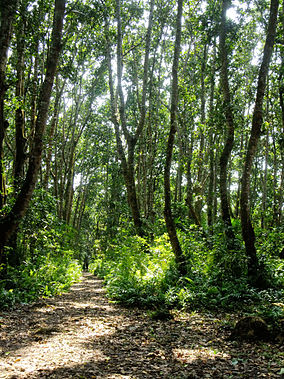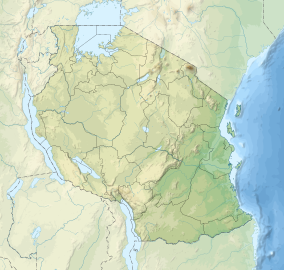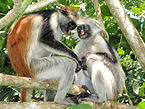Jozani Chwaka Bay National Park
| Jozani Chwaka Bay National Park | |
|---|---|
 | |
| Location | Zanzibar, Tanzania |
| Nearest city | Jozani |
| Coordinates | 6°13′59″S 39°24′14″E / 6.233°S 39.404°E[1] |
| Area | 50 km2 (19 sq mi) |
| Established | 2004 |
| Governing body | Tanzania National Parks Authority |
| www | |
The Jozani Chwaka Bay National Park is a 50 km2 (19 sq mi) national park in Tanzania located on the island of Zanzibar. It is the only national park in Zanzibar.
The Zanzibar red colobus,
Another animal in the forests of the Unguja Island unequaled elsewhere is the Zanzibar leopard (Panthera pardus adersi).[6] which was believed to be extinct. In Swahili, a leopard is called 'Chui' and is part of the superstitious beliefs of the people. People believe that sorcerers keep this animal as their pet and scare people by spinning stories that the animal appears like spirits and disappears into thin air,[6] which most likely comes from the fact that Leopards are very shy of humans and elusive. It was last reported in 1999 and officials, and men working on the "coral rag" lands of the southern and eastern Ungula Island are assertive that the species is not extinct, though it has not been sighted since 2003. The last sighting reported in 2002-2003 was of two leopards. Photographs of live examples of the species are not known to exist, although a stuffed example is a museum display in Zanzibar Museum, and a few skins exist in museums in London and Massachusetts. Trail camera footage from a 2018 American documentary television series does appear to have captured proof of the leopard's existence and will undoubtedly spark renewed interest and further protective enforcements. A smaller leopard with spots, which is a biological product of the larger animal, is seen now in the island.[8]
The sea grass beds of the Chwaka Bay, fringed with mangrove forests, are important breeding grounds for marine organisms, including open sea fish species. The mangroves are also good breeding grounds for birds. An Integrated Conservation and Development (ICD) planning for the area is under consideration. The bay is also proposed to be declared a
Ecology
According to the
Endangered animals that reside within the park include:
- the Zanzibar red colobus (Piliocolobus kirkii), an endemic monkey species that exists only in Zanzibar.[11][12][13]
- the Aders' duiker(Cephalophus adersi)
- the Zanzibar servaline genet (Genetta servalina archeri)
- the Zanzibar leopard
Important Bird Areas
The park encompasses two adjoining
Ecotourism
A revenue sharing program from park entrance fees has been used to construct schools and health clinics for local villages.[17]
Gallery
-
Kirk's red colobus of Zanzibar, Procolobus kirkii, taken in Jozani Chwaka Bay National Park.
-
Red colobus monkeys in Jozani forest.
References
- ^ "Jozani Chwaka Bay National Park". protectedplanet.net.
- ^ "Wild Life Zala Park". Zanzibar.org.
- ^ a b "The Jozani Forest Reserve". Commission for Tourism. Retrieved 13 June 2011.
- ^ Inventory Acc.942 Papers of Sir John Kirk GCMB KCB and Lady Kirk née Helen Cooke. National Library of Scotland: Manuscripts Division.
- ^ Pakenham, R.H.W. (1984). The Mammals of Zanzibar and Pemba Islands. Harpenden: privately printed.
- ^ a b c "Walk on the wild side". Mambomagazine.com. Archived from the original on 2 June 2011. Retrieved 13 June 2011.
- ISBN 978-0-520-25649-1. Retrieved 13 June 2011.
- ^ "The Zanzibar Leopard between Science and Cryptozoology". East Africa Natural History Society. Retrieved 10 June 2011.[permanent dead link]
- ^ "Mnemba Island and Chwaka Bay Conservation Areas:A Preliminary Situational Assessment" (PDF). Department of Fisheries and Marine Resources: Government of Zanzibar. July 2005. pp. vi, xi. Archived from the original (PDF) on 25 March 2012. Retrieved 21 June 2011.
- ^ ISBN 978-2-8317-0436-4. Retrieved 2009-03-03.
- ^ a b c Mukabana-Inzira, Lillian (2008-11-13). "Zanzibar's evergreen Jozani National Park: The community has a voice in its conservation". IPP Media. Archived from the original on November 13, 2008. Retrieved 2009-03-03.
- .
- ^ Salum, Layla M. (2009). "Ecotourism and biodiversity conservation in Jozani-Chwaka Bay National Park, Zanzibar (abstract)". African Journal of Ecology, Volume 47, Supplement 1; Blackwell Publishing. Retrieved 2009-03-03.
- ^ "Jozani Forest". BirdLife Data Zone. BirdLife International. 2021. Retrieved 28 February 2021.
- ^ "Zanzibar Island - East Coast". BirdLife Data Zone. BirdLife International. 2021. Retrieved 28 February 2021.
- ]
- ISBN 978-1-84376-257-7. Retrieved 2009-03-03.



